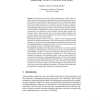Free Online Productivity Tools
i2Speak
i2Symbol
i2OCR
iTex2Img
iWeb2Print
iWeb2Shot
i2Type
iPdf2Split
iPdf2Merge
i2Bopomofo
i2Arabic
i2Style
i2Image
i2PDF
iLatex2Rtf
Sci2ools
CORR
2010
Springer
2010
Springer
Deploying Wireless Networks with Beeps
Abstract. We present the discrete beeping communication model, which assumes nodes have minimal knowledge about their environment and severely limited communication capabilities. Specifically, nodes have no information regarding the local or global structure of the network, do not have access to synchronized clocks and are woken up by an adversary. Moreover, instead on communicating through messages they rely solely on carrier sensing to exchange information. This model is interesting from a practical point of view, because it is possible to implement it (or emulate it) even in extremely restricted radio network environments. From a theory point of view, it shows that complex problems (such as vertex coloring) can be solved efficiently even without strong assumptions on properties of the communication model. We study the problem of interval coloring, a variant of vertex coloring specially suited for the studied beeping model. Given a set of resources, the goal of interval coloring is t...
| Added | 09 Dec 2010 |
| Updated | 09 Dec 2010 |
| Type | Journal |
| Year | 2010 |
| Where | CORR |
| Authors | Alejandro Cornejo, Fabian Kuhn |
Comments (0)

